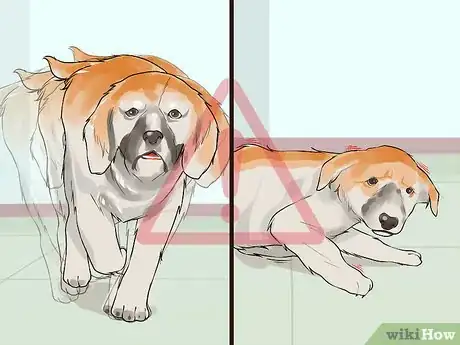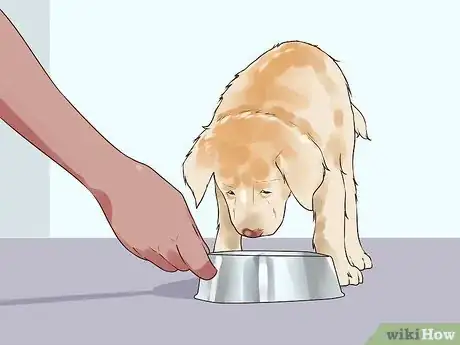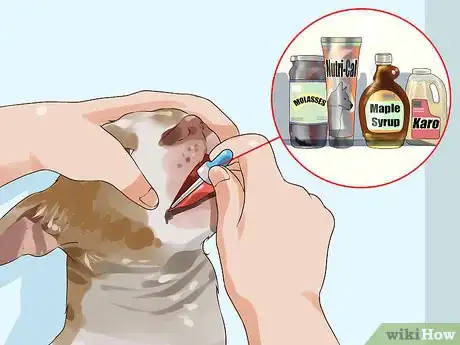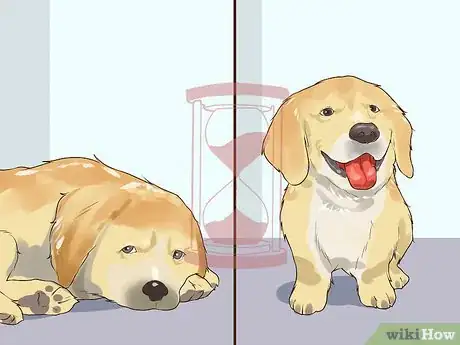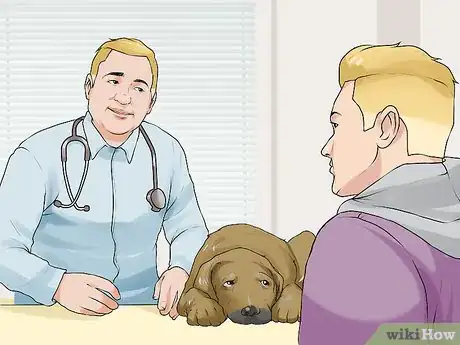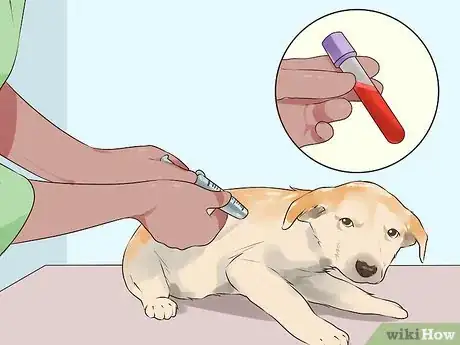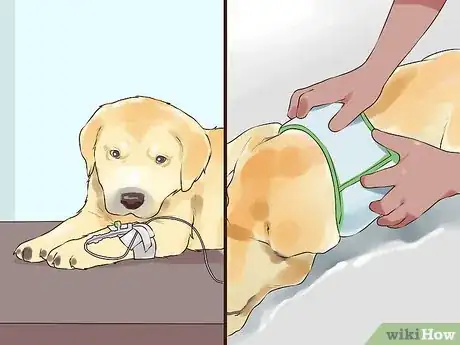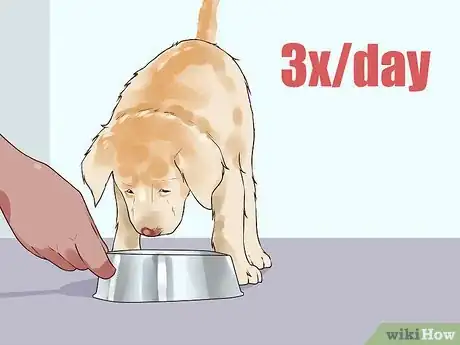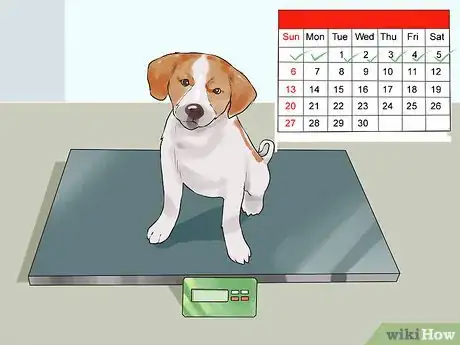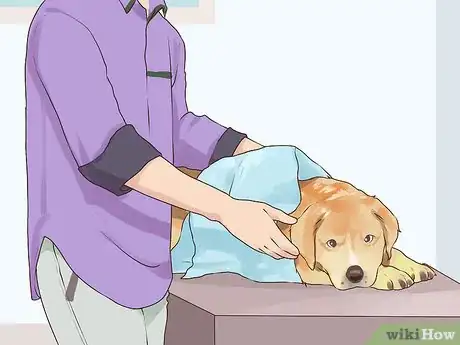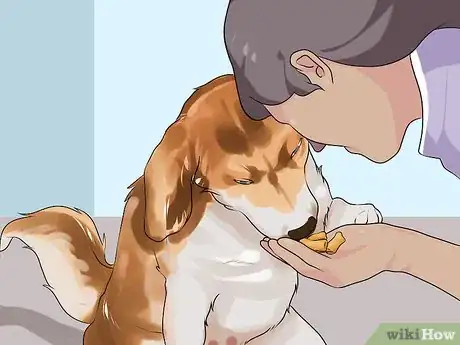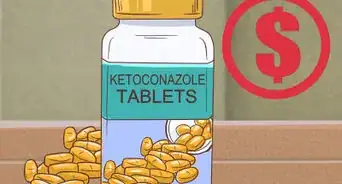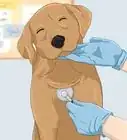This article was co-authored by Deanne Pawlisch, CVT, MA. Deanne Pawlisch is a Certified Veterinary Technician, who does corporate training for veterinary practices and has taught at the NAVTA-approved Veterinary Assistant Program at the Harper College in Illinois and in 2011 was elected to the board of the Veterinary Emergency and Critical Care Foundation. Deanne has been a Board Member of the Veterinary Emergency and Critical Care Foundation in San Antonio, Texas since 2011. She holds a BS in Anthropology from Loyola University and an MA in Anthropology from Northern Illinois University.
There are 11 references cited in this article, which can be found at the bottom of the page.
This article has been viewed 38,847 times.
Hypoglycemia occurs when blood glucose levels become too low. In young puppies, it is usually caused by a poor diet or not eating enough food, but can also result from health problems (intestinal parasites) and too much exercise.[1] Hypoglycemia can make a young puppy very sick, so it is important to handle hypoglycemia quickly and effectively. If your young puppy is showing signs of hypoglycemia, start treating it immediately, take your puppy to your vet, and prevent future bouts of hypoglycemia.
Steps
Providing Immediate Care
-
1Recognize hypoglycemia. Glucose gives the body energy. If your puppy is hypoglycemic, you'll first notice it moving more slowly and becoming restless. As the hypoglycemia worsens and your puppy’s brain is starved for glucose, your puppy will tremble, have a blank stare, and fall on its side.[2] Other signs of hypoglycemia include:[3]
- Fatigue
- Weakness
- Wobbly walking
- Shivering
- Head tilt
-
2Feed your puppy. As soon as you notice your young puppy looking restless, try feeding it some food.[4] Eating a little bit of food may be enough to raise your puppy’s blood glucose back to normal levels.[5] If your puppy does not want to eat, then you will need to feed it something sweet like honey, corn syrup, or sugar dissolved in water.
- If your young puppy is still nursing, you may need to bottle feed it.
Advertisement -
3Select a sugar source. A small dose of sugar will help to quickly raise your puppy’s blood glucose levels. Rather than giving your puppy sugar crystals, give it a liquid sugar source:[6]
- Nutri-Cal® (available at your local pet store)
- Maple syrup
- Karo syrup
- Molasses
-
4Administer the sugar source. Give your puppy the sugar source by either rubbing a small amount on the gums with your finger or placing a few drops under your puppy’s tongue.[7] Placing the sugar source on the gums or under the tongue will help it be absorbed more quickly by the body.[8]
- One to two tablespoons of a sugar source is usually enough to revive a small dog with hypoglycemia.[9] If your young puppy is really tiny, ask your vet about how much you should give.
- You can also place a few drops of the sugar source on your puppy’s tongue.[10]
- If you’re going to give drops of the sugar source, use a medicine dropper.
- To prevent your puppy from choking, do not put the sugar source directly down its throat.[11]
-
5Wait for your puppy to perk up. In many instances of puppy hypoglycemia, just a small amount of sugar will be enough to revive the puppy.[12] If the hypoglycemia is not severe, your puppy should perk back up in one to two minutes.[13] If your puppy does not respond, contact your vet immediately.
- Be aware that the sugar source is just a quick fix. Your puppy’s blood glucose levels may drop again, causing another episode of hypoglycemia.[14]
- If your puppy becomes hypoglycemic again, give it more of the sugar source and contact your vet.
-
6Give your puppy a small meal. If you needed to give your puppy a sugar source to handle its hypoglycemia, feed it a small amount of high-quality canned puppy food once it perks up.[15] The food will give your puppy more glucose and help it recover.
- If your puppy refuses the canned food, try feeding it some tasty treats.[16]
Receiving Veterinary Care
-
1Take your puppy to your vet. Even if your puppy looks fine after getting a little bit of sugar, your vet should still examine your puppy to determine if a health problem has caused the hypoglycemia. If your puppy did not respond at all to the sugar, then a vet visit is essential to get your puppy the intensive care it will need to recover.
- Your puppy will also need to see your vet if it responded to the sugar, but became hypoglycemic again.[17]
-
2Have your vet diagnose the hypoglycemia. Your vet will need to confirm that your young puppy has hypoglycemia. They will first perform a physical exam of your puppy. Then, they will take a small blood sample to measure your puppy’s blood glucose levels.[18]
- Intestinal parasites can rob your young puppy’s body of important nutrients like glucose. Your vet may also perform a fecal exam to look for intestinal parasites.[19]
-
3Allow your vet to treat the hypoglycemia. If your puppy has severe hypoglycemia, it will need immediate and intensive treatment by your vet. To administer this treatment, your vet will need to hospitalize your puppy for at least one day. Examples of intensive treatment for young puppies with hypoglycemia are:[20]
- Intravenous dextrose (a type of sugar)
- Deworming (kills intestinal parasites)
- Heat therapy
- Fluids
Preventing Hypoglycemia
-
1Maintain a regular feeding schedule. A young puppy’s body cannot regulate its blood glucose levels very well. Feeding your young puppy multiple times a day, at the same times each day, can help prevent hypoglycemia.[21] Puppies should eat 3-4 times a day, depending on their age.[22]
- Leave the food out for 10 to 20 minutes. This will help prevent your puppy from becoming a picky eater—it will learn that it should eat right away, rather than pick at the food for a long time.[23]
-
2Feed your puppy a high-quality puppy diet. A healthy puppy diet, when fed multiple times a day, will help keep your young puppy’s blood glucose levels from dropping too low. Also, high-quality puppy food will give your puppy the nutrients it needs to grow into a healthy adult dog.[24]
- Many types of puppy diets are available. If you are unsure which one is right for your puppy, talk with your vet for guidance.
- Puppies have specific nutritional needs. Do not feed your puppy an adult dog diet.
- Canned foods tend to be tastier than dry foods.[25] Your puppy may prefer canned food.
- Realize that the feeding guidelines on the food label may not work for your young puppy. Talk with your vet to determine how much you should feed your puppy at each meal.
-
3Weigh your puppy each day. A puppy should gain a little bit of weight every day. Daily weight gain means it’s eating enough food and getting enough nutrients, including glucose. Try weighing your puppy using a gram scale, which you can purchase a kitchen supply store. Record the weight on a piece of paper.[26]
- If your young puppy is too big or wiggly for a gram scale, try this: Weigh yourself on a regular scale, then hold your puppy in your arms. To get your puppy’s weight, subtract your weight from the weight of you and your puppy.
- If your puppy is not gaining weight, or is losing weight, it could be sick. Take your puppy to your vet.
-
4Keep your puppy warm. A cold puppy will use up extra glucose to stay warm, causing a condition called juvenile hypoglycemia. To prevent this type of hypoglycemia, wrap your young puppy in extra blankets to keep it warm. Also, keep your home at a warm temperature.[27]
-
5Reduce your puppy’s stress. Stress can cause a young puppy to become hypoglycemic. Examples of stressful events are vaccinations (or vet visits in general), over-handling, illness, and changes in a puppy’s environment.[28] Minimizing your puppy’s stress can help prevent hypoglycemia.
- Give your puppy treats when it behaves well at the vet’s office. That way, it may not get so stressed when it’s there.
- Do not try to handle your puppy all the time. Give it some alone time so it can rest.
- Keep your puppy’s routine the same from day to day.
Warnings
References
- ↑ http://www.peteducation.com/article.cfm?c=2+2108&aid=877
- ↑ https://papillonclub.org/articles-hypoglycemia/
- ↑ http://www.petdiabetes.com/pdorg/hypoglycemia.htm
- ↑ http://www.marvistavet.com/toy-breed-hypoglycemia.pml
- ↑ http://www.petdiabetes.com/pdorg/hypoglycemia.htm
- ↑ https://virtuavet.wordpress.com/2010/08/04/low-blood-sugar-can-kill-a-puppy/
- ↑ https://papillonclub.org/articles-hypoglycemia/
- ↑ https://www.vetinfo.com/symptoms-hypoglycemia-dogs.html
- ↑ http://www.petdiabetes.com/pdorg/hypoglycemia.htm
- ↑ http://leerburg.com/bottlefeeding.htm
- ↑ Small Animal Internal Medicine. Third Edition. Nelson WR and Couto CG. Page 731.
- ↑ http://leerburg.com/bottlefeeding.htm
- ↑ Small Animal Internal Medicine. Third Edition. Nelson WR and Couto CG. Page 731.
- ↑ http://www.petdiabetes.com/pdorg/hypoglycemia.htm
- ↑ https://papillonclub.org/articles-hypoglycemia/
- ↑ http://www.petdiabetes.com/pdorg/hypoglycemia.htm
- ↑ http://www.petdiabetes.com/pdorg/hypoglycemia.htm
- ↑ https://www.vetinfo.com/symptoms-hypoglycemia-dogs.html
- ↑ https://papillonclub.org/articles-hypoglycemia/
- ↑ https://virtuavet.wordpress.com/2010/08/04/low-blood-sugar-can-kill-a-puppy/
- ↑ https://www.vetinfo.com/symptoms-hypoglycemia-dogs.html
- ↑ http://www.humanesociety.org/animals/dogs/tips/housetraining_puppies.html
- ↑ http://www.akc.org/content/health/articles/puppy-feeding-fundamentals/
- ↑ http://www.akc.org/content/health/articles/puppy-feeding-fundamentals/
- ↑ https://virtuavet.wordpress.com/2010/08/04/low-blood-sugar-can-kill-a-puppy/
- ↑ https://virtuavet.wordpress.com/2010/08/04/low-blood-sugar-can-kill-a-puppy/
- ↑ https://www.vetinfo.com/symptoms-hypoglycemia-dogs.html
- ↑ https://papillonclub.org/articles-hypoglycemia/
- ↑ http://www.marvistavet.com/toy-breed-hypoglycemia.pml
- ↑ http://www.petdiabetes.com/pdorg/hypoglycemia.htm
- ↑ http://www.peteducation.com/article.cfm?c=2+2108&aid=877
- ↑ http://www.petdiabetes.com/pdorg/hypoglycemia.htm
About This Article
To handle hypoglycemia in a young puppy, feed it as soon as you notice symptoms, which may raise its blood glucose to a healthy level. If your puppy won't eat, get a liquid sugar source, like maple syrup or molasses, and rub 1-2 tablespoons of it into your puppy's gums or underneath its tongue. If your puppy doesn't perk back up in a couple of minutes, contact a vet immediately. For more advice from our Veterinary co-author, like how to prevent hypoglycemia from reoccurring, scroll down!
